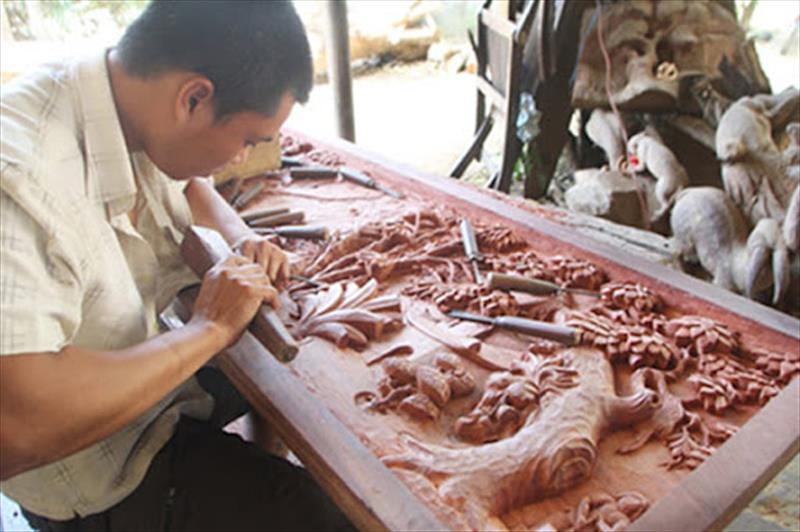Thai Yen Carpentry Village in Ha Tinh

Origin and History of Thai Yen Carpentry Village
The residents of Thai Yen are mainly indigenous people who have lived here for generations, with some migrants from northern provinces. According to tradition, the initial group of settlers in the village was small, with only a few dozen households making a living by clearing wild land and cultivating crops. By the late 16th century to the early 18th century, the population stabilized and grew.
Thai Yen Carpentry Village was established in the 13th century during the Tran dynasty. Poet Nguyen Thiep praised the village with the lines: "Huong Tich in the Tran Dynasty - The first ranking peak on the beautiful Ngan Hong Mountain." In 1885, the village was ravaged by a large fire. In 1901, Dao Tan, the governor of An Tinh province, contributed funds for restoration. In 1936, King Bao Dai inscribed the village's name on Anh Dinh, one of the nine large bronze urns in the Imperial City of Hue.
The Development of Thai Yen Carpentry Village
Thai Yen Carpentry Village experienced significant growth from 1995 to the present, considered the "golden era" of the craft village. The village has around 1200 households engaged in carpentry, accounting for 80% of all households in the commune. The hardworking residents continuously strive to improve the beauty and attractiveness of their products, working tirelessly day and night. From morning till night, the sound of carving, sawing, planing, milling, and varnishing echoes throughout the village.
The raw materials include various types of wood such as ironwood, rattan, mahogany, sandalwood, and gold core, sourced from the western regions of Ha Tinh and Nghe An provinces. Currently, the village has 50 carpentry workshops, each providing regular employment for 15-20 workers, with an average income of over 1 million VND per person per month. In addition to specialized production facilities, hundreds of households also utilize by-products to create common household items to serve customers.
Distinctive Products of Thai Yen Carpentry Village
Thai Yen Carpentry Village specializes in producing high-quality wooden furniture such as tables, chairs, beds, cabinets, altars, and traditional wooden beds. The products feature diverse and rich designs, suitable for various spaces and styles. The meticulous craftsmanship, sharp details, and exquisite carvings make these products highly valuable, with some sets of traditional wooden beds and altars priced over 30 million VND.
.jpg)
Moreover, Thai Yen Carpentry Village also produces various wooden items for worship, including trays, incense burners, and commemorative wooden items like paintings, statues, and boxes. These products carry high cultural and artistic value, reflecting the soul and essence of Thai Yen craftsmen.
Challenges in the Woodworking Industry in Thai Yen
Thai Yen Carpentry Village faces challenges in its production activities. One major challenge is the shortage of raw materials. Due to over-exploitation and extensive deforestation, natural wood resources are decreasing, leading to higher wood prices due to high demand. Residents must import wood from distant provinces such as Quang Binh, Quang Tri, or even from Cambodia and Laos. This increases production costs and reduces profitability.
Another challenge is brand competition. As Thai Yen Carpentry Village has long been famous, there are many imitations or counterfeits attempting to deceive consumers. This negatively impacts the reputation and quality of the craft village. The people of Thai Yen must make efforts to protect their brand and explore new markets.
Thai Yen - A Cultural Land
Thai Yen Carpentry Village not only excels in carpentry but also boasts numerous valuable cultural and historical landmarks. Some notable destinations include:
- Thai Yen Temple: A venerable and sacred ancient temple built around 1679, recognized as a national cultural and historical monument in 1994. The temple venerates deities such as Quy Minh, Thai Binh, Thai Yen, Thai Hoa, Thai Thuan, and national heroes like Nguyen Viet Duc, Nguyen Viet Triem, Nguyen Viet Tai. The temple features unique and impressive architecture, including Three Gates, Dai Hung Buu Dien, Phat Quang Dien, and the Rear Palace. Numerous stone steles inside the temple record important historical events of Thai Yen Carpentry Village.
- Saint Joseph Church: A beautiful and ancient architectural structure built in 1928 by Father Phaolo Nguyen Van Tuong. The church is a place of worship for Jesus and Saint Joseph, the patron saint of carpentry. The church resembles a large ship, with a red-tiled roof and a tall bell tower. Inside the church, there are many wooden artworks created by Thai Yen carpenters, including altars, statues of Jesus, statues of Mother Mary, and statues of saints.
Thai Yen Carpentry Village in Ha Tinh is a long-standing and reputable traditional craft village. The village not only produces high-quality and beautiful wooden products but also preserves the valuable cultural and historical values of the country. Thai Yen Carpentry Village is an attractive destination for travelers who love exploration and religion when visiting the land of Ha Tinh.

